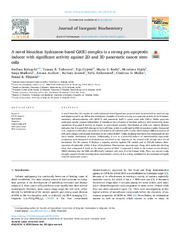| dc.creator | Bjelogrlić, Snežana | |
| dc.creator | Todorović, Tamara R. | |
| dc.creator | Cvijetić, Ilija N. | |
| dc.creator | Rodić, Marko V. | |
| dc.creator | Vujcić, Miroslava | |
| dc.creator | Marković, Sanja | |
| dc.creator | Araskov, Jovana | |
| dc.creator | Janović, Barbara | |
| dc.creator | Emhemmed, Fathi | |
| dc.creator | Muller, Christian D. | |
| dc.creator | Filipović, Nenad | |
| dc.date.accessioned | 2020-12-17T22:37:05Z | |
| dc.date.available | 2020-12-17T22:37:05Z | |
| dc.date.issued | 2019 | |
| dc.identifier.issn | 0162-0134 | |
| dc.identifier.uri | http://aspace.agrif.bg.ac.rs/handle/123456789/5050 | |
| dc.description.abstract | A novel binuclear Cd complex (1) with hydrazone-based ligand was prepared and characterized by spectroscopy and single crystal X-ray diffraction techniques. Complex 1 reveals a strong pro-apoptotic activity in both human, mammary adenocarcinoma cells (MCF-7) and pancreatic AsPC-1 cancer stem cells (CSCs). While apoptosis undergoes mostly caspase-independent, 1 stimulates the activation of intrinsic pathway with noteworthy down regulation of caspase-8 activity in respect to non-treated controls. Distribution of cells over mitotic division indicates that 1 caused DNA damage in both cell lines, which is confirmed in DNA interaction studies. Compared to 1, cisplatin (CDDP) does not achieve cell death in 2D cultured AsPC-1 cells, while induces different pattern of cell cycle changes and caspase activation in 2D cultured MCF-7 cells, implying that these two compounds do not share similar mechanism of action. Additionally, 1 acts as a powerful inducer of mitochondrial superoxide production with dissipated trans-membrane potential in the majority of the treated cells already after 6 h of incubation. On 3D tumors, 1 displays a superior activity against CSC model, and at 100 M induces disintegration of spheroids within 2 days of incubation. Fluorescence spectroscopy, along with molecular docking show that compound 1 binds to the minor groove of DNA. Compound 1 binds to the human serum albumin (HSA) showing that the HSA can effectively transport and store 1 in the human body. Thus, our current study strongly supports further investigations on antitumor activity of 1 as a drug candidate for the treatment of highly resistant pancreatic cancer. | en |
| dc.publisher | Elsevier Science Inc, New York | |
| dc.relation | info:eu-repo/grantAgreement/MESTD/Basic Research (BR or ON)/172055/RS// | |
| dc.rights | openAccess | |
| dc.source | Journal of Inorganic Biochemistry | |
| dc.subject | Cd(II) complex | en |
| dc.subject | Hydrazones | en |
| dc.subject | Apoptosis | en |
| dc.subject | Cancer stem cells | en |
| dc.subject | DNA interactions | en |
| dc.subject | HSA interactions | en |
| dc.title | A novel binuclear hydrazone-based Cd(II) complex is a strong pro-apoptotic inducer with significant activity against 2D and 3D pancreatic cancer stem cells | en |
| dc.type | article | |
| dc.rights.license | ARR | |
| dc.citation.epage | 66 | |
| dc.citation.other | 190: 45-66 | |
| dc.citation.rank | M21 | |
| dc.citation.spage | 45 | |
| dc.citation.volume | 190 | |
| dc.identifier.doi | 10.1016/j.jinorgbio.2018.10.002 | |
| dc.identifier.fulltext | http://aspace.agrif.bg.ac.rs/bitstream/id/3564/5047.pdf | |
| dc.identifier.scopus | 2-s2.0-85055090720 | |
| dc.identifier.pmid | 30352315 | |
| dc.identifier.wos | 000452938900006 | |
| dc.type.version | publishedVersion | |


